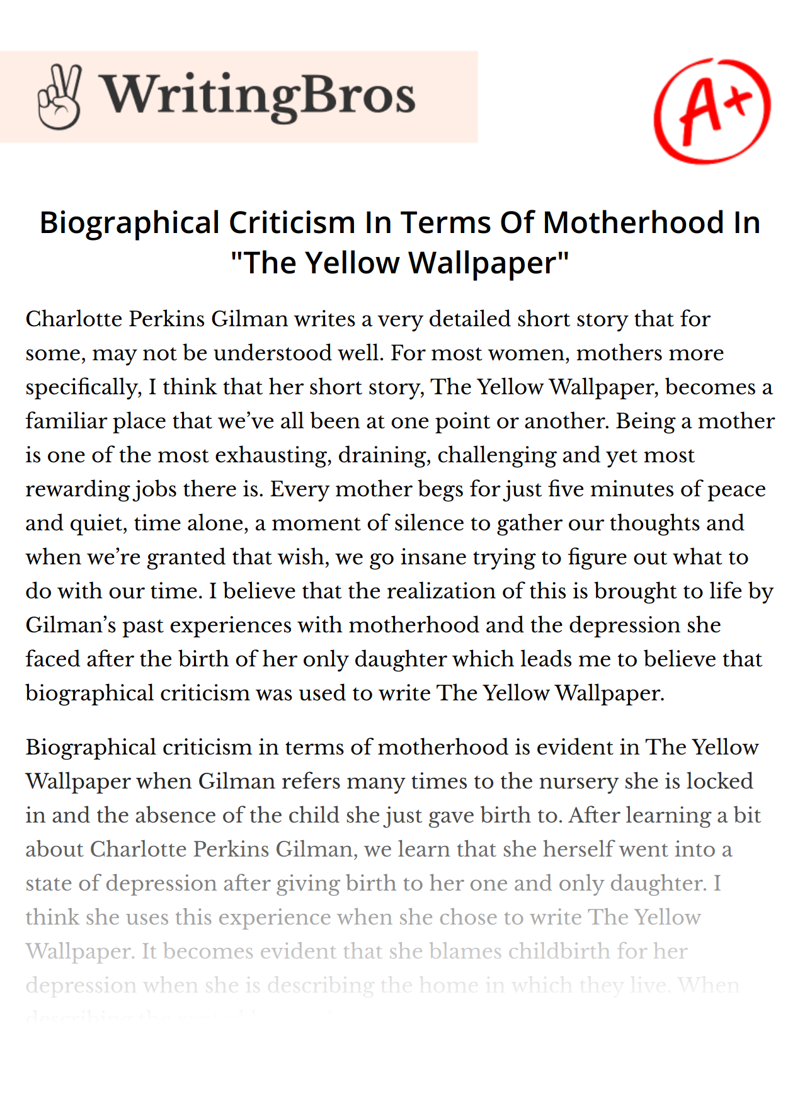Biographical Criticism In Terms Of Motherhood In "The Yellow Wallpaper"

Charlotte Perkins Gilman writes a very detailed short story that for some, may not be understood well. For most women, mothers more specifically, I think that her short story, The Yellow Wallpaper, becomes a familiar place that we’ve all been at one point or another. Being a mother is one of the most exhausting, draining, challenging and yet most rewarding jobs there is. Every mother begs for just five minutes of peace and quiet, time alone, a moment of silence to gather our thoughts and when we’re granted that wish, we go insane trying to figure out what to do with our time. I believe that the realization of this is brought to life by Gilman’s past experiences with motherhood and the depression she faced after the birth of her only daughter which leads me to believe that biographical criticism was used to write The Yellow Wallpaper.
Biographical criticism in terms of motherhood is evident in The Yellow Wallpaper when Gilman refers many times to the nursery she is locked in and the absence of the child she just gave birth to. After learning a bit about Charlotte Perkins Gilman, we learn that she herself went into a state of depression after giving birth to her one and only daughter. I think she uses this experience when she chose to write The Yellow Wallpaper. It becomes evident that she blames childbirth for her depression when she is describing the home in which they live. When describing the rented house she states, “The most beautiful place!” (297). She uses words of delight in describing most rooms of the house except when it is time to describe the nursery. The nursery is where she is to rest and it becomes her room. The very reason she is needing rest now becomes her prison. The way Gilman describes the nursery, the place she is trapped, the wallpaper, the barred windows, immediately lets the reader’s know that this is her nightmare. While describing the wallpaper that drives her mad she expresses to the reader that “It is dull enough to confuse the eye in following, pronounced enough constantly to irritate and provoke study, and when you follow the lame uncertain curves for a little distance they suddenly commit suicide — plunge off at outrageous angles, destroy themselves in unheard-of contradictions”. I think this is her way of describing how she must have felt when being treated for depression.
Trapped inside her own mind with nowhere to go. Gilman, like many women, felt as though motherhood and being a good mother, was what was expected, but she was having contradicting feelings that made her go into a place she had never experienced. Once you’re there, it’s hard to escape the four walls that slowly close in on you. I think that she took the way she felt and put it on paper in an exquisite manner and used those dark and trying moments in her personal life to help and educate others on how it felt to have no way out of a place one hates to be. Not only does Gilman use the nursery as the main setting for her short story, but she is clear to make known that she has no contact with the infant she just birthed.
As a reader, this makes me think that because she was trapped in the room with the yellow wallpaper, she had no way to interact with her infant, which I can imagine is exactly how Gilman felt when being depressed after the birth of her only daughter. When a mother loses contact with a child, I think that the absent of the child is enough to drive most mothers to insanity. I think that this may have been something only mothers could relate to while reading The Yellow Wallpaper. Gilman describes the longing for her baby when she writes “It is fortunate Mary is so good with the baby. Such a dear baby!” (299). I think immediately that as a mother, Gilman expresses that one is capable of loving a child even when they’re not capable of caring for it due to depression. It is something many mothers have faced which is why I so easily see biographical criticism in Gilman’s The Yellow Wallpaper. As a mother, I must applaud Gilman for taking so personal and real experiences and putting them on paper.
Depression is a hard thing to cope with much less when having to care for an infant. Gilman portrays the sadness and feeling of entrapment excellently through the use of biographical criticism while explaining the dreadful paper of the nursery and the absence of her newborn child in The Yellow Wallpaper. I think that by being able to relay the pain and feeling of being left alone to cope with several emotions at once is not easy to do and yet, Gilman does it so effortlessly in this short story.
Cite this Essay
To export a reference to this article please select a referencing style below

